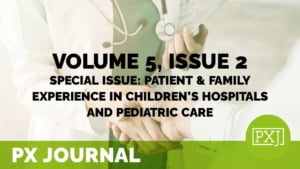PXJ Article
Showing 545–560 of 563 results
-
 Infrastructure & Governance
Infrastructure & GovernanceVolunteer contributions in the emergency department: A scoping review
Learn more -
 Infrastructure & Governance
Infrastructure & GovernanceWait time reality check: The convergence of process, perception, and expectation
Learn more -
 Staff & Provider Engagement
Staff & Provider EngagementWe did our Best!: The Experience of Frontline Workers in Long-Term Care during COVID-19 Outbreaks
In Canada, the COVID-19 pandemic had devastating effects for those living in long-term care (LTC) homes, yet little is known about the experiences of the frontline workers who endured in those settings with COVID-19 outbreaks. Specialized knowledge will improve our understanding of the effects of the pandemic on frontline workers (FW), enabling the development of
Learn more -
 Policy & Measurement
Policy & MeasurementWeighting patient satisfaction factors to inform health care providers of the patient experience in the age of social media consumer sentiment
Learn more -
 Policy & Measurement
Policy & MeasurementWhat are the most important dimensions of quality for addiction and mental health services from the perspective of its users?
Learn more -
 Policy & Measurement
Policy & MeasurementWhat are the sources of patient experience feedback in the UK prison setting, and what do patients and healthcare staff think about giving and receiving feedback in prison? A qualitative study
Background: The collection of patient experience feedback (PEF) has seen a marked global increase in the past decade. Research about PEF has concentrated mainly on hospital settings albeit a recent interest in primary care. There has been minimal research about PEF in the prison healthcare setting. The aim of this study was to explore the
Learn more -
 Environment & Hospitality
Environment & HospitalityWhat constitutes the patient experience of children? Findings from the photo elicitation and the video diary study
Learn more -
 Environment & Hospitality
Environment & HospitalityWhat Makes a Hospital Gown Functional? A Comparative Case Study of Effective Patient-Centered Design Practices in Four (n=4) Hospital Gowns
A hospital gown is essentially a patient uniform. Yet, the typical “tie in the back” hospital gown, standard garb for routine medical procedure, can have great influence over key intervention factors like receptiveness to treatment and patient self-esteem. Thus, the goals of this study are two-fold: 1) To understand patient perceptions of the standard hospital
Learn more -
 Culture & Leadership
Culture & LeadershipWhat matters most to patients? Participative provider care and staff courtesy
Learn more -
 Culture & Leadership
Culture & LeadershipWhat medicine can learn from pediatrics: A mother’s perspective
Learn more -
 Patient Family & Community Engagement
Patient Family & Community EngagementWhat older adults want from their health care providers
Learn more -
 Culture & Leadership
Culture & LeadershipWhen healthcare leadership and philanthropy lead to an improved patient experience: The Paul Lepsoe Music Initiative
Through an unprecedented collaboration between an academic acute tertiary care hospital (The Ottawa Hospital (TOH) and a community-based professional orchestra (Ottawa Symphony Orchestra (OSO), the Paul Lepsoe Music Initiative represented an innovative partnership focused on improving patient care via (a) the integration of live music in waiting areas of the hospital’s Cancer Center and (b)
Learn more -
 Infrastructure & Governance
Infrastructure & GovernanceWhen one is sick and two need help: Caregivers’ perspectives on the negative consequences of caring
Learn more -
 Culture & Leadership | Patient Family & Community Engagement
Culture & Leadership | Patient Family & Community EngagementWhich patient experiences are you capturing? Investigating differences in patient experience drivers by race/ethnicity and survey mode
Learn more -
 Culture & Leadership
Culture & LeadershipWhose party is it anyway? An invitation from a patient experience advocate
In this commentary, the associate editor of Patient Experience Journal (PXJ) discusses the need to center the human experience in health care by celebrating its essential human, the patient. We have a duty to honor and uphold the dignity of the importance of patient priorities, needs, and preferences, and those of their families. We honor,
Learn more -
 Culture & Leadership
Culture & LeadershipWhy do they do that?: Looking beyond typical reasons for non-urgent ED use among Medicaid patients
Learn more